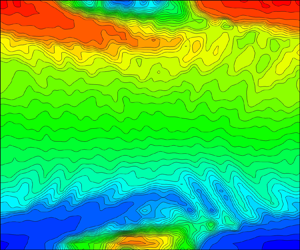Published online by Cambridge University Press: 26 April 2021

The instability and transition to turbulence and its evolution in pulsatile flows, which involve reverse flows and unsteady flow separations, is the primary focus of this experimental work. A piston driven by a programmable DC servo motor was used to set-up a water flow system and provide the pulsation characteristics. Time-resolved particle image velocimetry data were acquired in a refractive index matching set-up by using a continuous wave laser and a high-frame-rate digital camera. The position of the piston was continuously recorded by a laser proximity sensor. Five different experiments were carried out with Reynolds numbers in the range of 535–4825 and Womersley numbers from 11.91 to 23.82. The non-stationarity of the data was addressed by incorporating trend removal methods involving low- and high-pass filtering of the data, and using empirical mode decomposition together with the relevant Hilbert–Huang transform to determine the intrinsic mode functions. This latter method is more appropriate for nonlinear and non-stationary cases, for which traditional analysis involving classical Fourier decomposition is not directly applicable. It was found that transition to turbulence is a spontaneous event covering the whole near-wall region. The instantaneous vorticity profiles show the development of a large-scale ring-like attached wall vortical layer (WVL) with smaller vortices of higher frequencies than the pulsation frequency superimposed, which point to a shear layer Kelvin–Helmholtz (K–H) type of instability. Inflectional instability leads to flow separation and the formation of a major roll-up structure with the K–H vortices superimposed. This structure breaks down in the azimuthal direction into smaller turbulence patches with vortical content, which appears to be the prevailing structural content of the flow at each investigated Reynolds number (Re). At higher Re numbers, the strength and extent of the vortices are larger and substantial disturbances appear in the free stream region of the flow, which are typical of pipe flows at transitional Re numbers. Turbulence appears to be produced at the locations of maximum or minimum vorticity within the attached WVL, in the ridges between the K–H vortices around the separated WVL and the upstream side of the secondary vortex where the flow impinges on the wall. This wall turbulence breaks away into the middle section of the pipe, at approximately  $Re \ge 2200$, by strong eruptions of the K–H vortices.
$Re \ge 2200$, by strong eruptions of the K–H vortices.